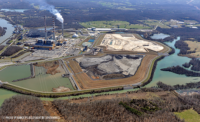Germany wants to take serious action on climate change. After more than six months of intense negotiations and years in the making, the country recently embarked on a path that will likely put an end to all its coal-fired power plants by 2038. The plan calls for shuttering a quarter of Germany’s coal-burners, some 12.5 gigawatts, within three years.
This is the result of contentious negotiation within a government-appointment panel bringing in industry, political and civic leaders and environmental interests, resulting in a 336-page phaseout plan (German PDF http://bit.ly/wsb_plan). Germany currently relies on coal for more than a third of its energy needs, and has already pledged to phase out nuclear power, which accounts for another 10%.
The coal plan, agreed to at the end of January, laid a marker: German Chancellor Angela Merkel has endorsed the 2038 target. Supporting the changeover and its social cost, which will affect large parts of the country’s coal centers in Saxony and eastern Germany as well as North Rhine-Westphalia, could run more than €40 billion ($45 billion). The commission plan proposes creating 5,000 jobs to bolster the move. The German government could lend support by relocating federal or state agencies to coal areas and also establish new state-sponsored research facilities in these regions.
Industry calculates costs, and now that the plan is on the table, calculations over the fallout are starting to surface: according to the German Press Agency, utility RWE estimates costs of around €1.2 billion ($1.35 billion) per gigawatt taken off line—and there are arguments brewing over which region will shut down plants first and when.
Analysts and industry are working out just how the coal plan as set out will fit into the complex systems of German infrastructure and what opportunities it might create for the construction and engineering sectors.
“I can’t really think of the government not implementing the plan,” says Timon Wehnert, head of the Berlin office for the Wuppertal Institute for Climate, Environment and Energy, a sustainable development research group. “That would be very difficult in terms of prestige … and we have climate targets.”
There may be wrangling on how to get there, but Berlin is committed to cutting carbon emissions and meeting (or coming close to) the ambitious climate change goals set out by the Paris Climate Accord. In other words, analysts in Germany take the coal plan seriously, even if environmental groups claim it is not ambitious enough. Last winter’s yellow-vest protesters in Paris were galvanized by the price of fuel, but their demonstrations expanded the conversation all across Europe.
Germany shuttered its last operating hard coal plant at the end of 2018 (brown lignite, or soft coal, still accounts for mining production). In Europe’s largest industrial power—a nation wedded to highly-engineered automobiles—renewables made up 35% of power consumption last year.
However it happens, the coal exit would appear to favor solar- and wind-oriented firms. Industry players, however, are either being cagey, still mulling over the move or treating construction prospects separately from what happens to the grid suppliers. Calgary-based energy transportation company Enbridge over the past five years has invested in offshore wind farms in the North Sea off both Britain and Germany, and is currently developing a 1,428 MW farm off the coast of France, following up on five large previous offshore wind investments. The company wouldn’t directly link its renewable plans to what happens elsewhere in energy infrastructure, including German plans for coal.
“We look at every one of our investments in the same way: as stable, low-risk opportunities that deliver solid returns, so if there is an opportunity that presents itself that follows this methodology we will look at it,” an Enbridge spokeswoman says. “All forms of energy sources will be needed to meet people’s needs as we shift to a low-carbon economy.” At Liebherr, the large German industrial manufacturer and one of the world’s largest crane producers, a company spokeswoman pointed out that the firm has “touchpoints” at several places in energy: Its mining division produces equipment for industry sectors including coal, while other divisions, including cranes for wind power plant and turbine installations, produce for renewables. Several European utilities did not respond for comment.
Analysts at the Bloomberg New Energy Finance research group expect that, in order to cope with coal and nuclear closures by 2022, Germany will need to add firm, flexible energy capacity; its modeling shows 4.5 GW of flexible gas added before 2022, as well as 200 MW of grid-scale battery storage.
The group’s European energy transition analyst, Diego Marquina, expects the 2038 plan could mean adding up to 15 GW of net gas capacity, 11 GW of grid-scale battery storage and roughly 5 GW of cogeneration conversions from coal to gas. This would be supported by more than 180 GW of additional wind and solar capacities over the coming 20 years. That translates into about 18,000 of the new Vestas or Siemens Gamesa turbines coming on line.
Marquina says requisite hybrid plants and new technology to deploy additional renewable capacity are needed regardless of the coal phaseout. However, it’s clear that such a big decision is going to need investing in other infrastructure such as gas, renewables, storage and grid expansion. Integrating all that wind and solar capacity implies both grid expansion and reinforcement; one group analysis of a new energy network plan could clock in with costs at €52 billion ($58 billion).
As Germany goes down the path of nuclear and coal phaseout, Wehnert says it has broader implications than just the energy sector. There is discussion in the German government about making line ministries with long reach into national infrastructure—its transport, buildings, agriculture—financially accountable for reaching climate goals. A Climate Action Law, due to be introduced this spring, would lend power to the idea. The German environment ministry is calling on other ministries to submit emission reduction plans by the end of March, reports Berlin-based Clean Energy Wire.
Chancellor Merkel presides over a government, her fourth and last, that is broadly seen as weakened and riven, and the Climate Action Law is getting pushback in the wake of the coal plan. But given the government’s ability to get industry and environmental interests to put down on paper a plan for a national coal phaseout, movement on it seems more likely than not.





